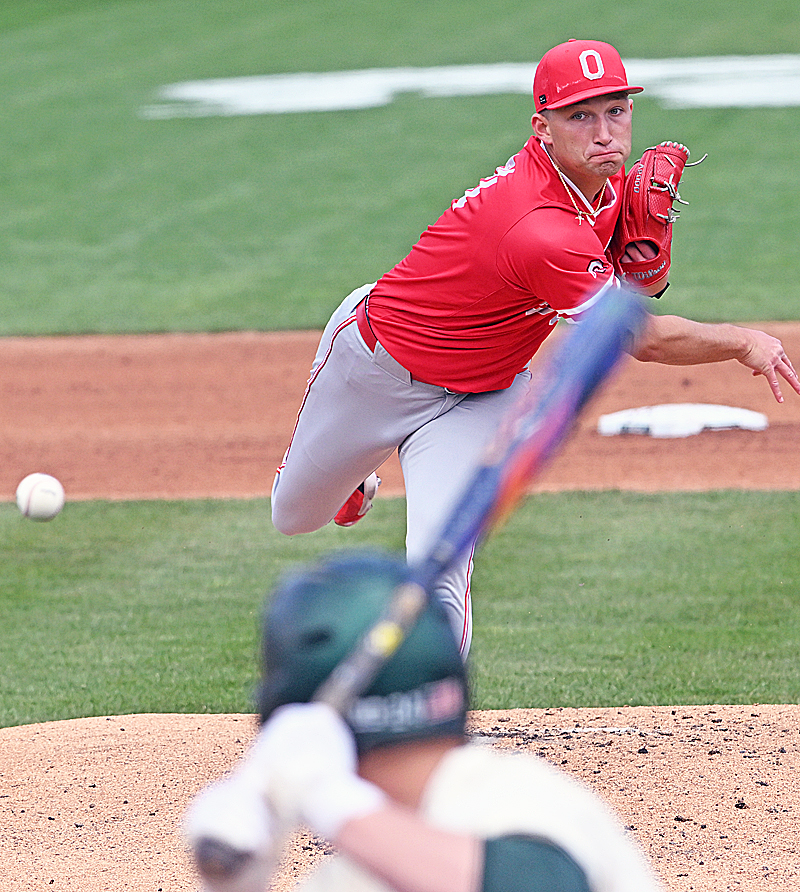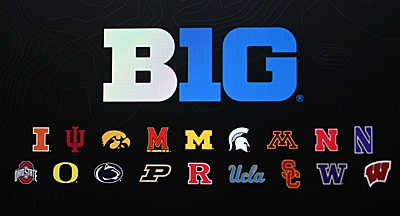
Jake Michalak was the first of six pitchers who saw action in Sunday’s finale. (Press Pros Feature Photos)
Run-ruled 14-4 in the finale of their weekend series with Michigan State Sunday, it was an all-too-familiar reminder of the priorities for improvement in 2026.
 East Lansing, MI – Sunday’s finale game of the weekend series with Michigan State was something not shocking – not anymore. Something you’ve grown accustomed to.
East Lansing, MI – Sunday’s finale game of the weekend series with Michigan State was something not shocking – not anymore. Something you’ve grown accustomed to.
Spartan leadoff man JT Sokolove singled off Ohio State starter Jake Michalak, stole second base, advanced to third on a wild pitch, then scored on an infield groundout…1-0, MSU.
In between all that Michalak struck out a pair and escaped the inning with a negotiable deficit for a team that scored ten runs Saturday in a losing effort.
But the second inning was also a familiar reprise of so many other innings over the previous twenty six losses.
Michalak walked the leadoff hitter. Hit a pair of batters…a strikeout…a walk to load the bases…an RBI fielder’s choice to score a run…then three consecutive singles and another walk before striking out the final out of the inning. Michigan State led 7-0, and was on its way to an eventual 14-4 run-rule win at the end of the seventh inning.
The Buckeyes did show life in the top of the third, scoring three times off MSU starter Nolan Higgins on a Reggie Bussey single, a hit batsman (Trey Lipsey), a walk to Tyler Pettorini, and a sac fly by Will Carpenter. And then Mason Eckelman singled to drive in Pettorini and the Buckeyes trailed 7-3…but for only about ten minutes.
Michigan State came back to score 4 in the bottom of the fourth off reliever Nik Copenhaver…then added another run in the fifth and 2 in the bottom of the seventh to close out the Buckeyes and their 27th loss of the season, 14-4. OSU’s other run came in the top of the fourth on a single by Bussey and an RBI double by Lipsey.
Not unseen in 2025, six different pitchers saw cooperative action in Sunday’s series finale – Michalak, Copenhaver, Zak Sigman, Sahil Patel, Simon Bargo and Tanis Lange.
The line scores….
Michigan State won with 14 runs on just 8 hits, had 1 error, and left 8 men on base. Another all-too-familiar stat…Ohio State pitchers walked an unfathomable 14 Michigan State hitters and hit three more. And nine of those 14 base runners scored!
Ohio State lost (9-27, 2-16 in Big Ten) with 4 runs on 6 hits and committed 2 errors. The Buckeyes left 6 men on base. The hitting star in Sunday’s finale was centerfielder Reggie Bussey, whose three singles raised his season average to .278.

Logan Services, in Dayton, Cincinnati, an Columbus, is a proud sponsor of area sports on Press Pros.
With twenty games left on the regular season schedule there are some realities to be addressed over the off-season in preparation for fall baseball and a hoped-for turnaround in 2026.
From day one of the 2025 season pitching has been an undetermined, unreliable, and hard-to-address achilles heel. There’s no denying it, going back to what was even written on these pages in January and February. The roster itself was athletic and would hit enough to score an average of six runs a game. But the trick has been…how to limit the opposition to less than six runs a game.
There have been the unforeseen issues.
The best ability is availability, and two starting pitchers, Blaine Wynk and Chase Herrell, have been lost to injury.
Beyond that fact, the Buckeyes’ offense has averaged 6.8 runs per game on offense, while the available pitching has allowed 337 runs through 36 games, and an average of 9.36 runs per contest – 50% more runs than they’ve been able to score.
The strikeout-to-walk ratio from the 2024 season that we cautioned about in February (approximately 2 strikeouts to 1 walk) is still out of whack, given that the current strikeout-to-walk ratio is almost 1 to 1 (285 strikeouts to 242 walks).
The staff earned run average is 9.02, and 9 of the 17 pitchers available have an ERA of 10.00 or better. The conference average is about 6.00, give or take.
So…the anatomy of 9-27, or the Buckeyes’ season, can be summed up with what Justin Haire said at the conclusion of the conference-opening series with Indiana, back on March 17.
“It’s hard to win games when you’re down 7-0 in the third inning,” he offered, and he wasn’t fooling. They were outscored by Indiana in that three-game set, 34-12; and they were outscored by Michigan State in this past weekend’s series, 35-17. Not much has changed, or improved.
The good news…?
There is talent with this pitching staff, enough velocity and spin to compete with anyone they’ve played for an inning or so. What’s lacking is experience, focus on the execution of pitches, and how to adjust during the course of the game.
One example, it’s hard to beat anyone when you’re constantly pitching from behind in the count. Statistics have shown for years that when you get ahead of the hitter 0-2, or 1-2, you get them out 75% of the time. Hitters with a 2-0 count hit about .350. Hitters with an 0-2 count hit about .150.
Another example…too many mistakes in the strike zone when the pitcher is ahead in the count. Those pitches get hit out of the park, and it’s happened too much this year.
And there’s an emphasis on velocity in contemporary baseball that’s led to a higher rate of base on balls, simply put.
And last, the diminished strike zone in college baseball is a deterrent to the development of young pitchers who are not physically mature as those in professional baseball.
The solution…?

The hitting star in Sunday’s finale was centerfielder Reggie Bussey, whose three singles comprised half of the Buckeyes hit total for the game.
The tincture of time, someone once said about all things developmental, and a personal commitment to improvement and efficiency. Because, it cannot be said that every available arm hasn’t had the opportunity to make a case for itself through thirty six games.
Can it be done…?
Apparently. Look at where Minnesota is now as opposed to where they were just two years ago (16-36). Or, look at the turnaround of Michigan State this year. \
 And finally, it can, and it does happen to other good programs.
And finally, it can, and it does happen to other good programs.
Nebraska, who won last year’s Big Ten Tournament, is currently 19-21, 7-11 in conference, and outside the top twelve seeds.
And Maryland, so good for so long, is now just 18-23, overall, and 5-13 in conference.
The beginning of the fix is as soon as the next twenty games, relative to Justin Haire’s season-long statement, “We have to get better.” And why wait?
9-27 ain’t a lot of fun!



